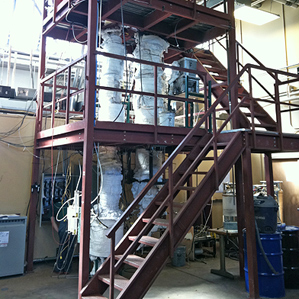 Check out this cool infographic talking about climate change and the impact it’s having on this planet. The thumbnail to the left is only a small portion, click on that for the full image.
Check out this cool infographic talking about climate change and the impact it’s having on this planet. The thumbnail to the left is only a small portion, click on that for the full image.
(via LivingGreen magazine)
A geek at the peak, in a world at the peak
 Check out this cool infographic talking about climate change and the impact it’s having on this planet. The thumbnail to the left is only a small portion, click on that for the full image.
Check out this cool infographic talking about climate change and the impact it’s having on this planet. The thumbnail to the left is only a small portion, click on that for the full image.
(via LivingGreen magazine)
The Internet of Things is best thought of as abundant networked, communicating smart devices all around you. Sensors, mostly, that are all communicating and making available unprecedented amounts of information about objects and the environment. Houses that know what rooms people are in, what rooms they are likely to be in next, and adjust HVAC systems accordingly to reduce energy consumption, for example. I’ve loved the idea of this from a technology geek perspective, but I hadn’t considered the environmental aspect until coming across this article talking about how it could offset billions of tons of CO2 through increased efficiency. Interesting idea…and it makes a lot of sense. We’d have to also consider the CO2 impact of actually producing so many sensors and networked objects, though.
2012 saw large increases in the amount of atmospheric CO2, with a jump of 2.67ppm (parts per million). As a comparison, between 2000 and 2010, the annual rate of increase was just under 2ppm; in the 1960s it was less than 1ppm. In spite of this data and political paralysis on the issue, scientists still talk as if we have some hope of averting catastrophic climate change on this planet. Let’s face it, the only way that will happen is if/when renewable energy becomes so much cheaper and more accessible to the average consumer that they’ll rush to embrace that. Until then, our greed and short-sightedness will keep us on this path. By the time the effects are so overwhelming that even the GOP has to pull their heads out of the sand and admit the problem, it’ll be too late to fix it.
Sorry, kids. Yes, we know exactly what our current course of action is doing to the environment you will rely upon when you’re our age. Or at least, we have a really, really good idea of what will happen, just some disagreement about the exact timing of things. Don’t let future history suggest otherwise. The people of this era are choosing this path for our own short term gain. I’m doing what I can to help influence others via this blog and my own actions, but it’s a really tough battle.
(via NBC news)
Scientists have identified exactly how it is that climate change may increase the likelihood of extreme weather events around the globe. You can read the full details here, but the gist of it is that there are normally what is, in essence, atmospheric ‘waves’ oscillating between the artic and tropic regions, which help mix things up. During recent extreme weather events, those waves were more or less frozen in place, something which climate change may make more likely as the planet is not heating uniformly (the poles heat more than the tropical areas, hence there’s less temperature different between them to drive the oscillations).
 The idea of ‘clean’ coal power has really been more of a marketing ploy and not something that environmentalists would agree with…until now, that is. Researchers at Ohio State University have proven a new clean coal technology in a 25kW facility ran for one week…far from the megawatt scale needed for industrial uses but no small feat and a great step towards that goal. The next step is a one megawatt demonstration plant already in the planning stages.
The idea of ‘clean’ coal power has really been more of a marketing ploy and not something that environmentalists would agree with…until now, that is. Researchers at Ohio State University have proven a new clean coal technology in a 25kW facility ran for one week…far from the megawatt scale needed for industrial uses but no small feat and a great step towards that goal. The next step is a one megawatt demonstration plant already in the planning stages.
So how does it work? Burning coal is a messy process, producing lots of gaseous byproducts that are difficult to separate and manage. This new process (“chemical looping”) reacts with materials rich in oxygen, like iron oxide (ie, rust). The energy in the coal breaks the bond between the oxygen and iron, which produces nearly pure CO2 as a byproduct (the other being iron metal and a mineral known as wustite). So, it still produces the greenhouse gas CO2, but that CO2 is nearly pure, meaning it’s much easier to contain it (at which point it can be used for industrial purposes or stored underground to not contribute to global warming). The pure iron is then burned in a separate process, which produces heat to generate steam and drive turbines to generate electricity.
This is expected to result in only small increases in the cost of electricity…whether it can be scaled up to power plant levels quickly enough is the real question.
(via TechnologyReview)
Proudly powered by WordPress | Theme: Baskerville 2 by Anders Noren.